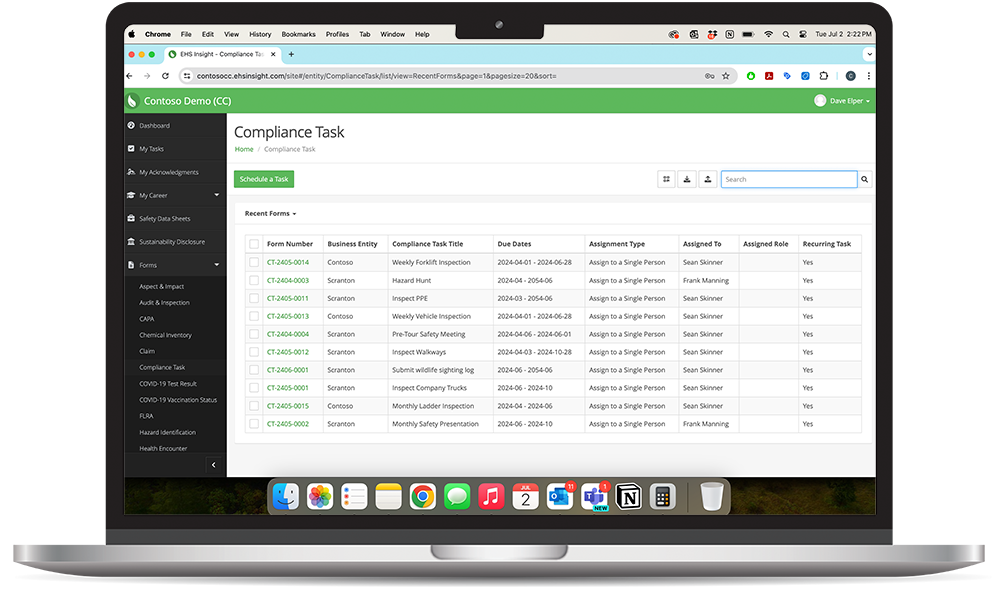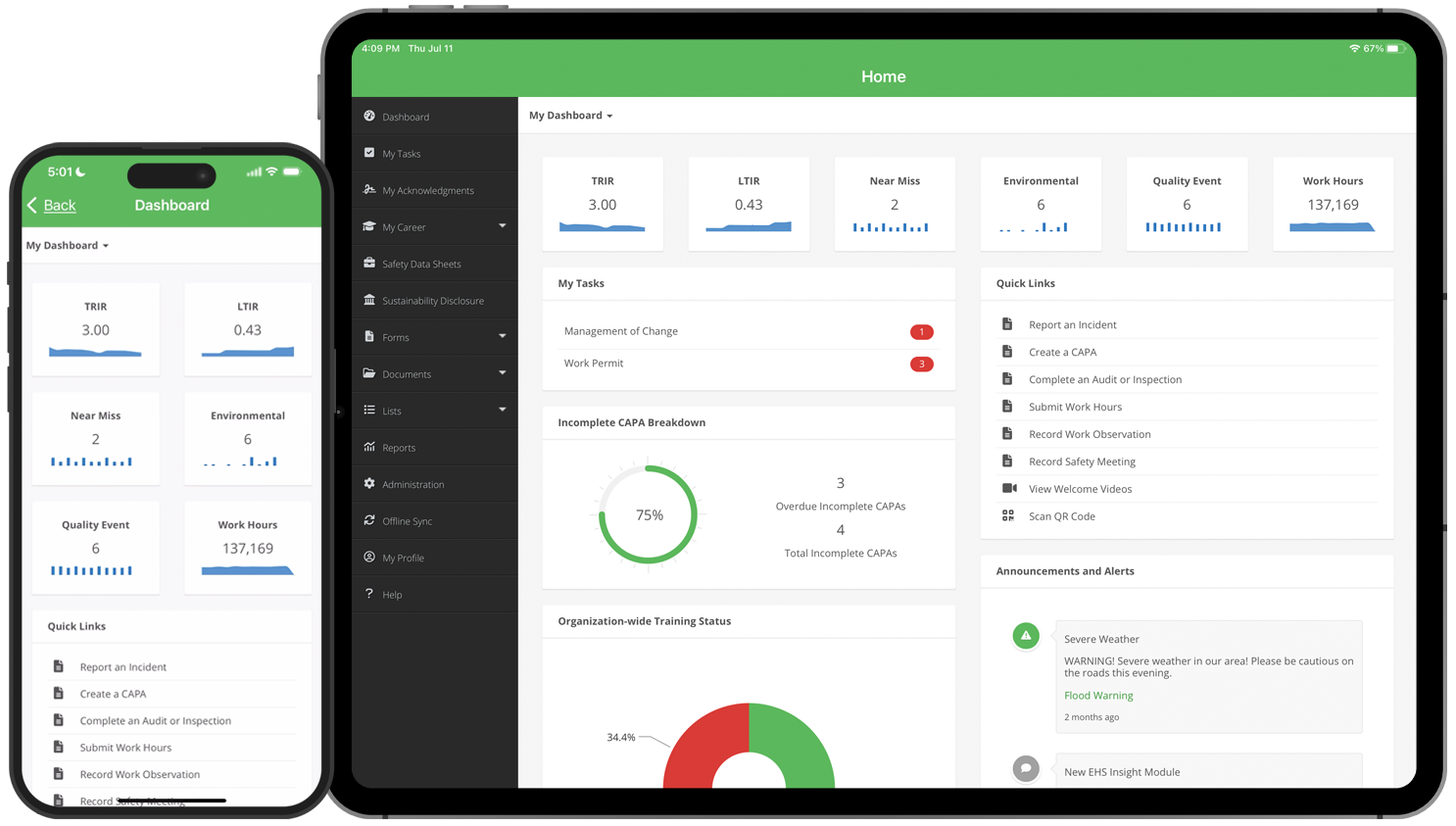Compliance Management Module
EHS Insight’s Compliance Management Module makes it simple to stay compliant — no matter your size or structure.
Whether you manage a single site or multiple locations, the system adapts to your needs and regulations.
Key Benefits
- Automated Workflows – Eliminate manual tasks and streamline compliance tracking.
- Audit Tracking – Easily monitor audits, findings, and corrective actions.
- Custom Fit – Configure the platform to match your organizational setup and compliance goals.
- Risk Reduction – Spot issues early and maintain control at every level.
Stay Ahead with Automated Compliance Tracking
Plan work in advance and use automation to stay compliant with regulatory, company, and other requirements—without the stress.
Watch the video to see how it works in action.
Keep Every EHS Obligation on Track—Automatically
Managing environmental, health, and safety requirements across multiple sites is complex.
EHS Insight’s Compliance Obligations Software makes it easier by helping you track, manage, and verify compliance in one place.
From permits to inspections to regulatory filings, you’ll always know:
- What’s due
- Who’s responsible
- Whether your team is on schedule
Nothing gets missed, and everything stays on track.

Key Features for Smarter EHS Compliance
Automated Compliance Workflows
Reduce manual effort with automated alerts, tasks, and follow-ups. Keep every action on track and ensure issues are resolved on time.
Centralized Obligation Tracking
Store all internal and regulatory requirements in one place. Track progress, documents, and assigned team members with ease.
Linked Corrective Actions & Audit Tracking
Connect obligations to audits, findings, and corrective actions for a clear view of ownership, status, and history.
Flexible Scheduling & Recurrence
Build schedules that match your reporting cycles, permit timelines, and local rules. Adjust them anytime as things change.
Real-Time Reporting & Dashboards
Access instant insights with live reports and user-friendly dashboards designed to keep your team informed and aligned.

The Benefits of EHS Insight's Compliance Platform

Gain Insight
Transparency creates accountability.
With company-wide visibility into compliance tasks, you can easily see how your organization is performing.
Use built-in data analysis tools to:
- Measure your current compliance level
- Spot gaps or trends
- Identify where improvements are needed
Clear insights lead to smarter decisions and stronger compliance.

Compliance Calendar
The Compliance Calendar makes it easy to schedule and assign recurring actions and audits.
Set reminders and escalations to keep teams accountable and ensure nothing slips through the cracks.
- Assign compliance tasks across multiple business entities
- View all scheduled tasks in one place
- Filter the calendar to see only the tasks assigned to you
It’s a simple way to stay organized and keep compliance on track.
EHS Insight Saves Time, Saves Money, and Improves Safety Cultures
What is compliance management software?
Compliance is essential for creating a safer workplace and reducing your impact on the environment and surrounding communities. Compliance software helps you communicate, monitor, and document all required activities.
It supports your organization by ensuring alignment with:
- Professional standards
- Industry regulations
- Government requirements
How EHS Insight Helps
EHS Insight’s regulatory compliance software includes a custom mode that lets you adjust data tracking and reporting to fit your needs.
This gives you the flexibility to manage compliance your way—while staying fully aligned with the rules that matter most to your business.
What tools are used for compliance management?
Businesses use a variety of tools to track and report compliance activities. Each type offers different levels of functionality and specialization.
All-Purpose Compliance Platforms
These tools are designed for any company or industry.
They offer broad, generic features but lack specialized capabilities for technical, governance, or remediation needs.
Industry-Specific Tools
Built for specialized sectors, these platforms provide deeper functionality tailored to unique regulatory requirements.
GRC Software
Governance, Risk, and Compliance (GRC) platforms combine:
- General compliance tools
- Specialized features
- Workflow automation
- Support for new compliance initiatives
They are among the most robust and comprehensive solutions available for managing compliance.
How fast can compliance software be implemented?
Our compliance tracking software is fully tailored to your organization—regardless of your industry or services.
During implementation, we customize the entire system to match your workflows, requirements, and goals.
Why Choose EHS Insight?
With EHS Insight, you get:
- A streamlined, efficient compliance process
- Lower implementation costs than many competitors
- Standardized, reliable support
- A solution built around your unique business needs
We work directly with your leadership team to ensure you’re equipped to turn compliance from a simple box-checking task into a strategic advantage.
Move Toward True Accountability
Boost transparency, strengthen accountability, and simplify compliance with a solution designed to grow with you.
Can compliance software be customized?
Stay compliant with domestic and international regulations.
EHS Insight helps you meet the high standards of OSHA, ISO 45001, RIDDOR, and other global requirements.
Your customized compliance management software gives you the tools to:
- Improve employee safety
- Identify risks before incidents occur
- Prepare confidently for any audit
Give your team peace of mind and maintain a safer workplace with a system built around your needs.
Ensure Compliance Across Your Entire Supply Chain
Regulatory compliance doesn’t stop at your organization. Every partner in your supply chain must meet the same standards.
EHS Insight supports this by helping you:
- Monitor supplier compliance
- Manage risk across every link
- Maintain consistent quality and performance
With user-friendly compliance monitoring tools, you can ensure no detail is missed—supporting smoother operations and long-term business growth.
What are the benefits of compliance software?
Effective compliance software delivers value across every industry and business size. As your organization grows—and your risks grow with it—compliance automation helps you stay ahead.
Key Advantages
- Scales with your business as compliance needs increase
- Eliminates manual workflows, boosting productivity
- Improves compliance success rates with consistent processes
- Streamlines implementation using built-in frameworks
- Supports corrective actions with clearer visibility and tracking
- Enhances reporting so leaders can address current and future risks
Investing in a compliance management system prepares your organization to handle today’s challenges—and anticipate tomorrow’s.
Empower your workforce with EHS Insight.
Over 500,000 users come to depend on EHS Insight for better team collaboration, accountability, and safety visibility.


